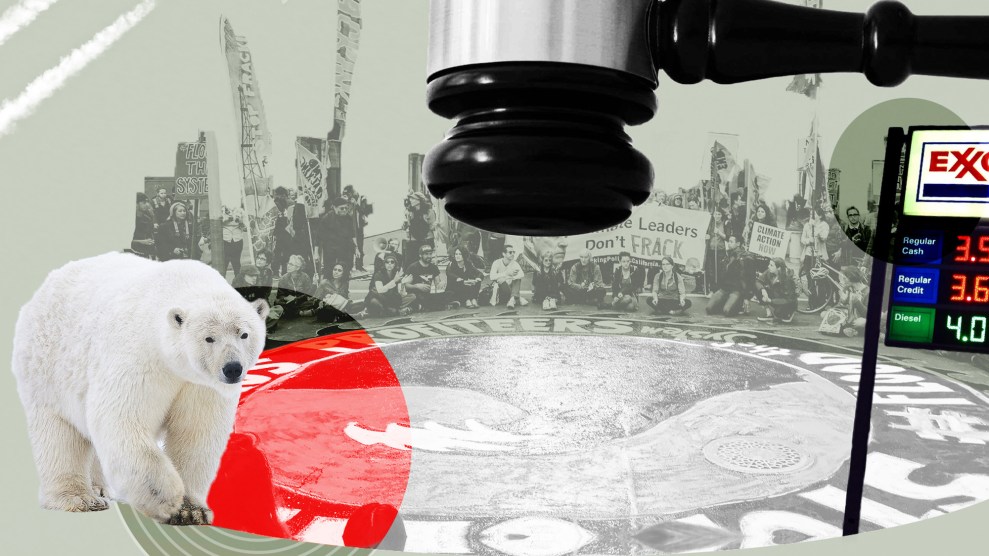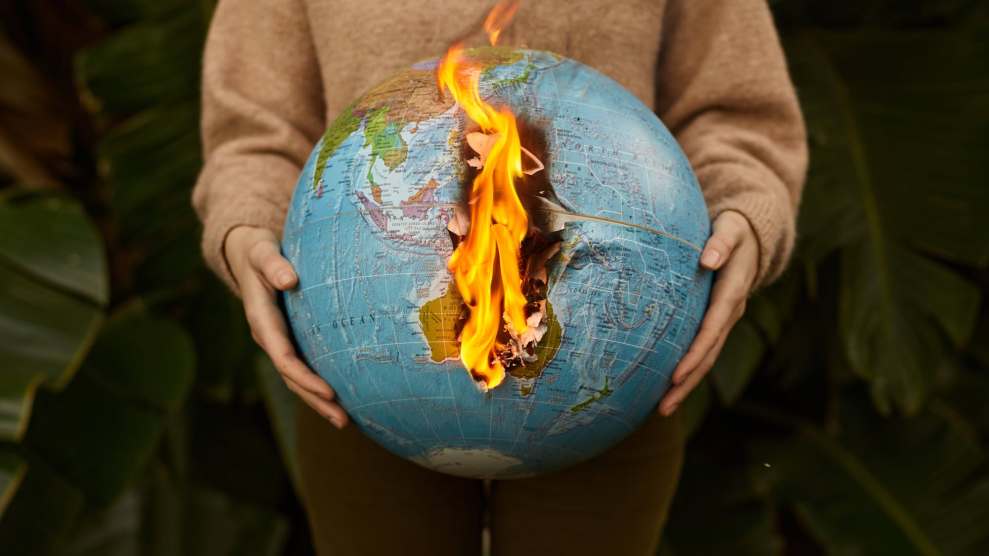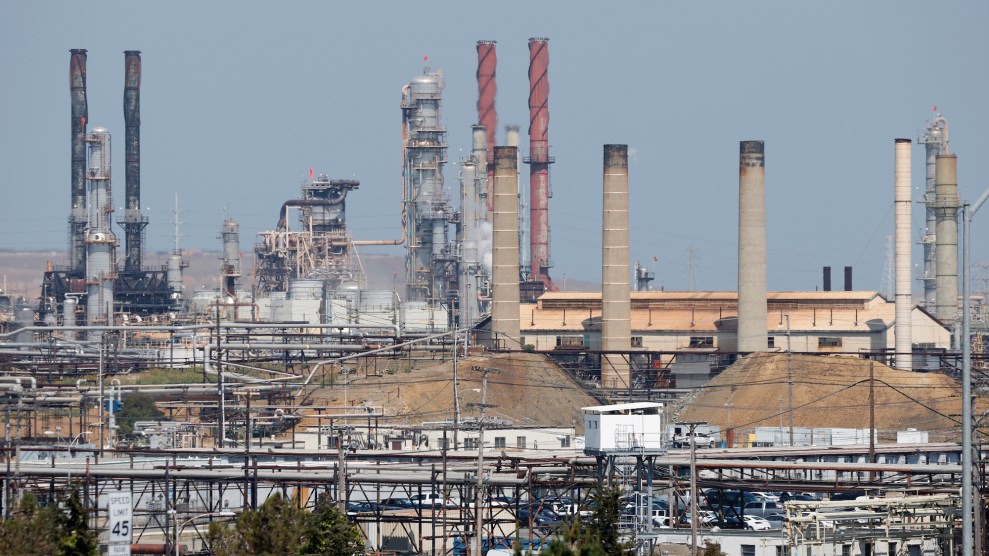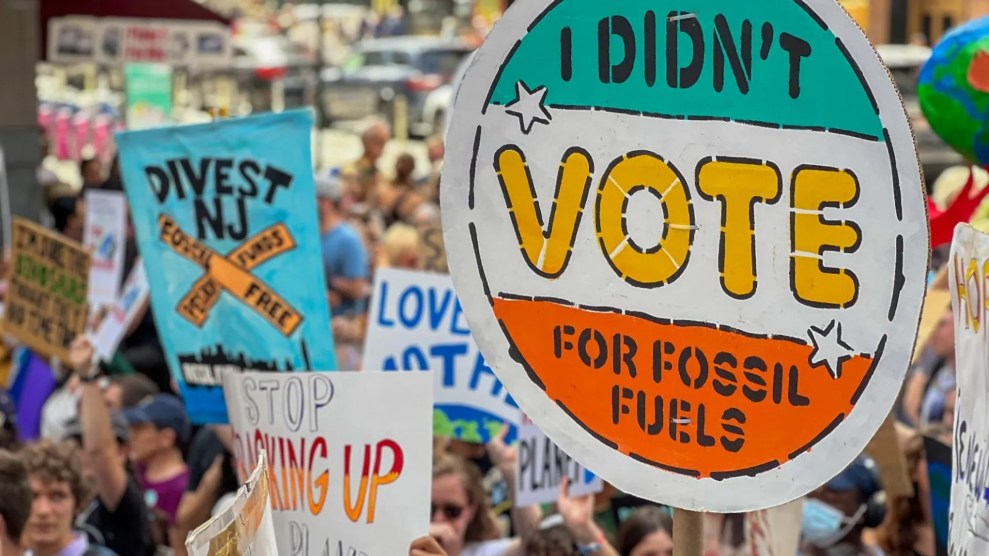
Ryan Rahman/Getty/Grist
This story was originally published by Grist and is reproduced here as part of the Climate Desk collaboration.
Last year, climate change came into sharp relief for much of the world: The planet experienced its hottest 12-month period in 125,000 years. Flooding events inundated communities from California to East Africa to India. A heat wave in South America caused temperatures to spike above 100 degrees Fahrenheit in the middle of winter, and a heat dome across much of the southern United States spurred a 31-day streak in Phoenix of 110 degree-plus temperatures. The formation of an El Niño, the natural phenomenon that raises temperatures globally, intensified extreme weather already strengthened by climate change. The US alone counted 25 billion-dollar weather disasters in 2023—more than any other year.
Yet this devastation was met by some of the largest gains in climate action to date. World leaders agreed for the first time to “transition away” from oil and gas at the annual United Nations climate summit, hosted last month by the United Arab Emirates. Funds and incentives from President Joe Biden’s signature climate law, the Inflation Reduction Act, started to roll out to companies and municipalities. Electric vehicle sales skyrocketed, thousands of young people signed up for the first-ever American Climate Corps, and companies agreed to pay billions of dollars to remove harmful chemicals called PFAS from drinking water supplies.
As we enter a new year, we asked Grist reporters what big stories they’re watching on their beats, 24 predictions for 2024. Their forecasts depict a world on the cusp of change in regard to climate—both good and bad, and often in tandem. Here’s what we’re keeping an eye on, from hard-won international financial commitments, to battles over mining in-demand minerals like lithium, to the expansion of renewable energy.
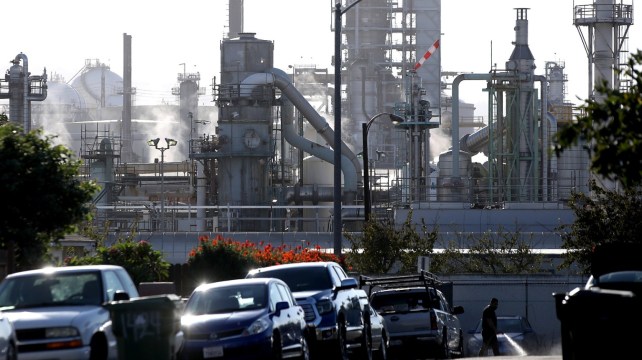
A ConocoPhillips refinery abuts a residential area in the Wilmington neighborhood of Los Angeles in 2022.
Luis Sinco / Getty / Grist
POLITICS & POLICY
1. A new climate corps will turn young people’s anxiety into action.
The American Climate Corps will officially kick off in the summer of 2024, sending 20,000 18- to 26-year-olds across the country to install solar projects, mitigate wildfire risk, and make homes more energy-efficient. President Biden’s New Deal-inspired program is modeled after Franklin D. Roosevelt’s Climate Conservation Corps and attracted 100,000 applicants. As it rolls out, the climate corps will continue to draw criticism from the left for low wages and ageism, and from the right for being a “made-up government work program … for young liberal activists.” Yet the program will remain popular with the public, bolstering towns’ resilience to weather disasters and training thousands of young people to help fill the country’s shortage of skilled workers needed for decarbonization. —Kate Yoder
2. Despite rising temperatures, climate change takes a backseat during the 2024 election.
Although more than a decade of surveys and polls show that a growing proportion of Americans are concerned about climate change, it has never been a defining issue in a general election—and will likely remain that way in 2024, at least on the main stage. Put simply, there are too many immediate concerns that will dominate the campaign trail as President Joe Biden faces off against the Republican nominee—most likely former President Donald Trump: Russia’s ongoing war in Ukraine, Israel’s war against Hamas, the overturning of Roe v. Wade and the fight for abortion rights, new charges against Biden’s son, Hunter, and, of course, the numerous criminal charges against Trump. Biden may herald his signature climate law, the Inflation Reduction Act, in his own messaging, but climate change is unlikely to cross party lines. —Zoya Teirstein
3. A climate reparations fund gets off the ground.
During COP28, the UN climate conference that took place in Dubai last year, countries agreed to set up a climate reparations fund on an interim basis at the World Bank. The fund was a longtime priority of developing countries and climate justice advocates who argued that nations that had contributed negligibly to a warming planet were facing the consequences. This year, the World Bank is expected to set up the fund and begin disbursing money to poor nations. Board members will be selected, an executive director will be appointed, decisions about how countries can access the money will be made, and money will begin flowing to those in need. During COP28, wealthy countries chipped in more than $650 million to the fund. More money will also fill the coffers this year. —Naveena Sadasivam
4. “Greenhushing” spreads as companies seek to dodge lawsuits.
Just a few years ago, splashy corporate climate promises were everywhere. Even oil companies promised to cut their emissions. But there won’t be as many misleading advertisements touting companies’ climate progress in 2024. Amid new regulations against false environmental marketing and a pileup of greenwashing lawsuits, more corporations will join in hiding their climate commitments to avoid scrutiny. This trend of “greenhushing” ramped up in 2023, when 1 in 5 companies declined to publicly release their sustainability targets, a threefold increase from the prior year. While this makes it harder to see what companies are doing, California’s new “anti-greenwashing” law, which went into effect on January 1, will tackle the transparency problem by requiring companies to disclose their carbon emissions. —Kate Yoder
5. A global treaty to end plastic pollution faces delays.
Delegates from around the world have been working to finalize a UN treaty by the end of 2024 that will “end plastic pollution.” They’ve had three negotiating sessions so far, and two more are scheduled for later this year. Despite signs of progress, petrochemical industry interests have resisted the most ambitious proposals to limit plastic production—they’d prefer a treaty focused on cleaning up plastic litter and improving plastic recycling rates. After countries failed to make significant headway at the most recent round of talks, it’s now possible that an extended deadline will be needed to deliver the final treaty. To some involved in the talks, that’s OK if it’ll mean a stronger agreement. But the pressure is still on, as every year without a treaty means more unchecked plastic pollution. —Joseph Winters
ENERGY
6. A deluge of new household electrification and efficiency rebates.
When the Inflation Reduction Act passed in 2022, some decarbonization incentives were quickly accessible—such as tax credits for solar and heat pump installation—but others have taken longer to kick in. The wait, however, is almost over, and 2024 is set to see a slew of new, or expanded, opportunities come online. The Inflation Reduction Act earmarked $8.8 billion for residential electrification and energy-use reduction, especially in low-income households.Think things like induction cooktops and energy-efficient clothes dryers, which don’t currently have federally funded rebates. The Department of Energy is in the process of allocating funding to participating states, which will be in charge of getting the money into Americans’ pockets. —Tik Root
7. A push for public power takes root in communities nationwide.
Across the country, close to a dozen communities are exploring ways to replace their investor-owned electric utilities with publicly owned ones. Advocates say they want to lower electricity costs, improve reliability, and speed up a clean energy transition. While a referendum in Maine to create a statewide publicly owned utility failed this past November, supporters elsewhere are just getting started. Next year, a group in San Diego could succeed in getting a vote for a municipal utility on the ballot. Decorah, Iowa, is contemplating a similar vote, and ongoing efforts could gain traction in San Francisco, the South San Joaquin Irrigation District in California, New Mexico, and Rochester, New York. —Akielly Hu
8. Puerto Rico becomes be a US leader in residential solar energy adoption.
While the nationwide rate of residential-solar installations is expected to shrink by more than 10 percent next year, due to interest rates and changes in California’s net-metering rules, installations show no sign of slowing down in Puerto Rico. The archipelago of 1.2 million households already installs 3,400 residential rooftop solar and battery-storage systems per month. In spring 2024, the Energy Department will begin deploying $440 million in residential-solar funding, which they say will be enough for about 30,000 homes. Analysts predict that by 2030, one-quarter of Puerto Rico households will have photovoltaic systems, though that depends in part on whether Puerto Rico passes a pending bill that would protect net metering until then. —Gabriela Aoun Angueira
BUSINESS & TECH
9. Changes to the federal tax credit will improve EV access for lower-income drivers.
As of January 1, consumers can redeem the Inflation Reduction Act’s clean-vehicle tax credit directly at car dealerships. Last year, the $7,500 incentive for new electric vehicles and $4,000 for previously owned ones were only available as a credit, meaning that car buyers had to wait until they filed their taxes to get any benefit. The point-of-sale rebate will make getting a clean vehicle more accessible to buyers who can’t afford a hefty down payment, or whose income is too low to owe taxes. But their model options will also shrink—the Treasury Department just proposed rules disqualifying cars with battery components or minerals that come from countries deemed hostile to the US. —Gabriela Aoun Angueira
10. Carbon-capture tech will continue to boom (and be controversial).
In some ways, it was a mixed year for carbon capture. While the world’s largest carbon-capture plant broke ground in Texas, the builders of a major carbon dioxide pipeline—which would be used to transport captive emissions to their final destination underground—canceled the project in the face of regulatory pushback. Climate activists have also long been skeptical of carbon capture as an industry ruse to keep burning fossil fuels. Overall, though, the carbon-capture market is surging on the tailwinds of largely favorable government policies in recent years. The use of the technology is also spreading beyond traditional sectors, such as natural gas facilities, into other industrial arenas, including cement, steel, and iron manufacturing. Next year will bring some continued hiccups but, overwhelmingly, continued growth. —Tik Root
11. Republicans ramp up their war on “woke” ESG investing.
An ongoing Republican crusade against ESG investing—shorthand for the environmental, social, and governance criteria investors use to evaluate companies—could end up costing retirees and insurers millions in lost returns next year. GOP lawmakers claim that considering climate risks while making investments imposes “woke” values and limits investment returns. Yet anti-ESG laws passed in Kansas, Oklahoma, and Texas last year were estimated to have cost taxpayers up to hundreds of millions of dollars. That’s partly because most Wall Street banks and businesses still employ ESG strategies. The backlash could continue through next year’s election—presidential candidates Ron DeSantis and Vivek Ramaswamy have both taken strong anti-ESG positions. —Akielly Hu
12. Unions expand their fight for electric vehicle worker protections.
United Auto Workers recently won provisions for electric vehicle employees after a sweeping strike at Detroit’s Big Three carmakers—Ford, Stellantis, and General Motors. Now, the union has launched organizing campaigns at 13 non-union shops, including at EV leaders like Tesla and at other companies just getting into the EV space, such as Volkswagen and Hyundai. Next year, these campaigns will begin to go public, with resulting walkouts, negotiations, and expected union-busting tactics. Such efforts have failed in the past, and some companies have announced wage increases to entice workers away from a potential union drive, but UAW has already announced thousands of new member sign-ups and filed labor grievances against several companies, signaling a hard-headed approach that may win new contracts to protect workers as the auto industry increasingly shifts toward EVs. —Katie Myers
ENVIRONMENTAL JUSTICE
13. The EPA will back away from using civil rights laws to protect residents.
In 2020, a federal judge ordered the Environmental Protection Agency to start investigating the complaints it receives under Title VI of the Civil Rights Act, which prohibits discrimination on the basis of race or national origin in any program that gets funding from the federal government. Since then, communities around the country have attempted to use the law to achieve environmental justice in their backyards. But after the agency dropped its highest profile civil rights case in Louisiana’s “Cancer Alley” following a lawsuit from the state attorney general, advocates worry that the legal avenue won’t fulfill its promise. In 2024, it’s likely that the EPA will pursue Title VI complaints in states with cooperative environment agencies, but shy away from pressuring industry-friendly states like Louisiana and Texas to make big changes based on the law. —Lylla Younes
14. Additional testing will reveal the true scope of “forever chemical” pollution.
Major chemical manufacturers like 3M, DuPont, and Chemours were forced to strike multibillion-dollar settlements last year with coalitions of states, cities, and townships over PFAS—the deadly “forever chemicals” these companies knowingly spewed into the environment for decades. 2024 will be a big year for determining just how pervasive this problem is in US water supplies. New hotspots are likely to emerge as the EPA conducts additional testing across the country, particularly in areas where little data on the chemicals currently exists. New fights over forever chemicals will also unfold in places like Minnesota, where lawmakers have introduced a bill that would require 3M and other large chemical corporations to pay for medical testing for PFAS-exposed communities, and in North Carolina, where the United Nations just declared PFAS pollution a human rights violation. —Zoya Teirstein
15. A booming liquefied natural gas industry goes bust…maybe.
The liquefied natural gas industry is booming on the US Gulf Coast as companies export huge amounts of fracked gas to Europe and Asia, but the buildout of liquefaction facilities in the South has stumbled in recent months. A federal court revoked one facility’s permit in Texas, and the federal Department of Energy denied another company seeking an extension to build a facility in Louisiana. The coming year will be a big test for the nascent business: If courts and regulators delay more of these expensive projects, the companies behind them may abandon them and instead try building smaller, cheaper terminals elsewhere in the United States or even offshore. —Jake Bittle
16. Polluting countries could be legally liable to vulnerable ones.
At COP28, negotiators from small island states sought to hold larger countries financially accountable for their outsize role in fueling carbon emissions. In 2024, that issue could be decided in international courts: As soon as March, the International Court of Justice will weigh arguments regarding countries’ obligations under international law to protect current and future generations from the harmful effects of climate change. The case brought by Vanuatu raises the question of how much big polluters owe island nations, with Vanuatu and other Pacific island communities particularly affected by rising sea levels and worsening storms. —Anita Hofschneider
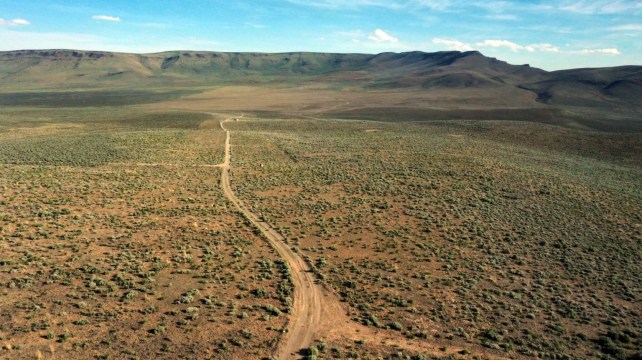
An aerial view of Thacker Pass in northern Nevada, where a proposed lithium mine has drawn impassioned protest from Indigenous people, ranchers, and environmentalists.
Carolyn Cole / Getty / Grist
LAND USE
17. Mining for critical minerals takes off, as new discoveries and investments are made.
Discoveries of major new deposits of rare earths and other minerals critical to the expansion of renewable energy will continue to explode in the western and southeastern US—places like the Salton Sea in California and a lithium belt in North Carolina—as well as in Alaska. These developments, alongside incentives from the Inflation Reduction Act, will bolster domestic mining and renewable energy industries in 2024. Many of these discoveries are being made in coalfields and oil fields by fossil fuel companies looking to diversify their portfolios. In response, expect a boom in the efforts to reform laws around the poorly regulated mining industry as well as community-driven activism against places like the Thacker Pass lithium mine in Nevada. —Katie Myers
18. Congress doles out funds for unproven “climate-smart” agriculture.
This could be the biggest year yet for “climate-smart” agriculture. Billions of dollars that Congress earmarked a year and a half ago in the Inflation Reduction Act are starting to flow to farmers planting trees and cover crops that sequester carbon. Lawmakers will have the chance to carve out even more funds in the farm bill, the sprawling legislative package that will be up for renewal next year. But climate advocates won’t be satisfied with all of the results: The fight over what counts as “climate smart” will heat up as subsidies go to tools like methane digesters, which some advocates blame for propping up big polluters. —Max Graham
19. More renewable energy comes to public lands.
The Bureau of Land Management controls a tenth of the land base in the US—some 245 millions acres. The Biden administration has been trying to utilize that public land for renewable energy projects and infrastructure, with the Department of Interior recently announcing 15 such initiatives. The department is also aiming to reduce fees to promote solar and wind development. These efforts have run into roadblocks in the past, including from Indigenous nations. For example, the Tohono O’odham Nation and San Carlos Apache Tribe challenged a transmission line in southern Arizona because of its potential to harm cultural sites. But with the goal of permitting 25 gigawatts of renewable energy on BLM land by 2025, expect the federal government to continue pushing its buildout next year. —Tik Root
CLIMATE IMPACTS
20. El Niño peaks, bringing a preview of life in the 2030s.
Last year brought the onset of the latest cycle of El Niño, a natural phenomenon that spurs the formation of a band of warm water in the Pacific Ocean and fuels above-average temperatures globally. In fact, the cycle has already nudged the world over 1.5 degrees Celsius (2.7 degrees Fahrenheit) of warming for the first time. Because these systems tend to peak from December to April, the worst impacts will likely hit in the first half of 2024. Scientists predict the world will experience its hottest summer on record, giving us a preview of what life will look like in the 2030s. El Niño has already spurred an onslaught of knock-on effects, including heat waves in South America, flooding in East Africa, and infectious disease outbreaks in the Americas and the Caribbean. This year, researchers expect El Niño will lead to an unusually strong hurricane season in the Pacific, impact agricultural production and food security, lead to more explosions of vector-borne diseases, and depress the global economy. In some places, this is already happening. —Zoya Teirstein
21. To migrate or not: Pacific islanders weigh their options.
Last year, a proposed treaty between Australia and Tuvalu made international headlines for a unique provision: migration rights for climate refugees from the Pacific island country, which is at particular risk of rising seas. Now, Tuvalu’s general election, set for later this month, may serve as a de facto referendum on the agreement. But the country’s voters aren’t the only ones weighing their options as their islands slowly sink. The coming year will bring more attention to the plight of Pacific Islanders who are confronting a future of forced migration and grappling with the question of where their communities will go, what rights they’ll have, and how their sovereignty will persist. —Anita Hofschneider
22. Insurers flee more disaster-prone states.
California. Louisiana. Florida. Who’s next? The insurance markets in these hurricane- and fire-prone states have descended into turmoil over the past few years as private companies drop policyholders and flee local markets after expensive disasters. State regulators are stepping in to stop this downward spiral, but stable insurance markets will mean higher prices for homeowners, especially in places like low-lying Miami, where the average insurance premium is already around $300 a month. The next year will see the same kind of insurance crisis pop up in other states such as Hawaiʻi, Oregon, and South Carolina, as private carriers try to stem their climate-induced losses. —Jake Bittle
23. Despite barriers, workplace heat standards make slow progress.
Earlier this year, Miami-Dade County in Florida—where the region’s humidity makes outdoor workers especially vulnerable to extreme heat—was poised to pass one of the most comprehensive and thoughtful workplace heat standards in the country. Instead, county commissioners bowed to pressure from industry groups, and the vote was deferred. On the national level, OSHA, the agency responsible for workplace safety, has been in the process of creating a federal heat standard for over two years. That work is far from over, and it seems unlikely that the agency will announce a finalized rule next year, despite record-breaking heat. That leaves states and municipalities to lead the way in 2024 for worker-heat protections, but as was the case in Miami-Dade, local officials will likely face obstacles from powerful industry groups as they do so. —Siri Chilukuri
24. “Heatflation” comes for desserts.
Heatflation came for condiments like olive oil and sriracha in 2023. This year, it’ll strike desserts. Unusually dry weather and a poor sugar cane harvest in India and Thailand—two of the world’s biggest producers—have driven global sugar prices to their highest level in more than a decade. Heavy rainfall in West Africa has led to widespread rot on the region’s prolific cocoa farms, causing chocolate prices to soar and snack companies like Mondelēz, which makes Oreos, to warn of more expensive products in 2024. And an extra-hot year fueled by a strong El Niño could be a rough one for wheat growers and flour prices. So now’s the time to indulge in chocolate cake—before it’s too late. —Max Graham
